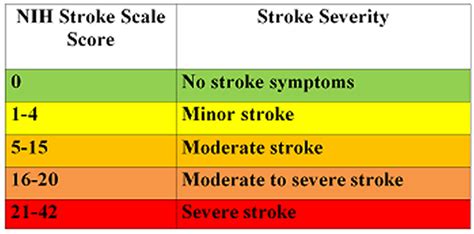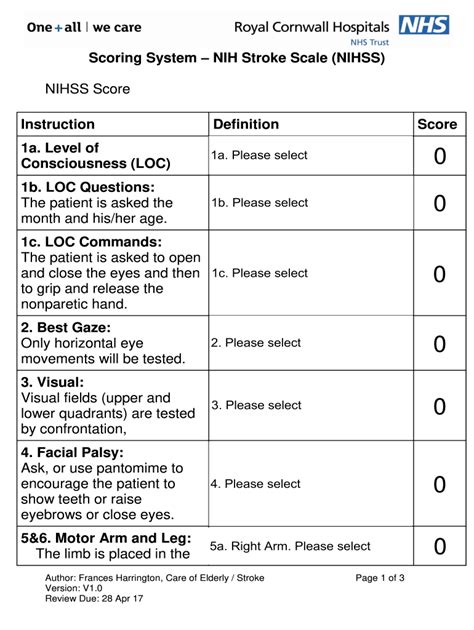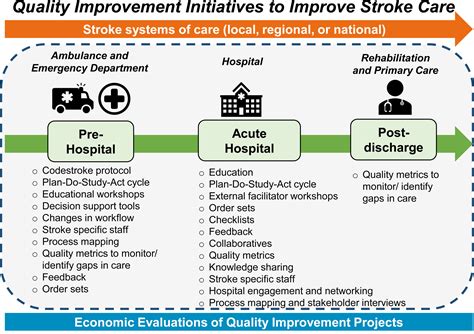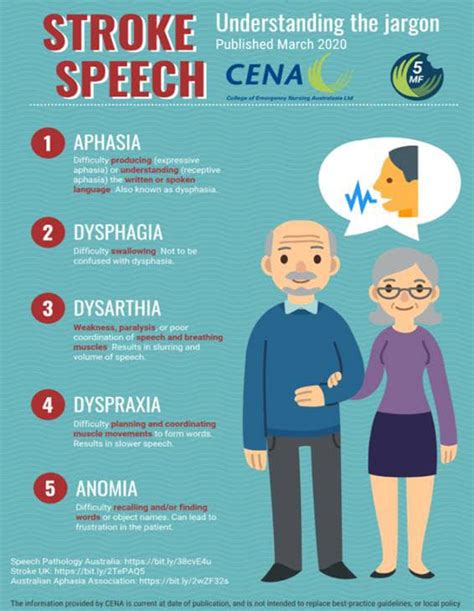Decoding NIH Stroke Scale: Group C Answer Key Unveiled

Unlock precise stroke assessment insights with our guide on the NIH Stroke Scale Answer Key Group C. Elevate your healthcare knowledge for accurate patient evaluations.
In the realm of healthcare, the NIH Stroke Scale Answer Key Group C serves as a crucial tool for assessing and quantifying the severity of stroke-related impairments. This article aims to shed light on this specific subset of the NIH Stroke Scale, delving into its intricate details and significance within the context of patient care. Understanding the nuances of Group C is paramount in ensuring accurate evaluations of neurological deficits in stroke patients. Throughout the following discussion on healthcare topics, we will navigate the key elements of this assessment, elucidating its role in facilitating comprehensive and standardized evaluations. So, let's embark on a journey into the intricacies of the NIH Stroke Scale, Group C, to unravel its importance in the realm of healthcare.
Top 10 Points about NIH Stroke Scale Answer Key Group C :
- Introduction to NIH Stroke Scale and Group C
- Importance of Accurate Stroke Assessments
- Understanding Neurological Deficits in Stroke Patients
- Exploring the Components of Group C Answer Key
- Application of NIH Stroke Scale in Clinical Settings
- Enhancing Stroke Patient Care Through Group C Assessment
- Interpreting Scores and Severity Levels
- Comparative Analysis of NIH Stroke Scale Groups
- Challenges and Considerations in Using Group C Answer Key
- Future Implications and Advancements in Stroke Evaluation
Several facts about NIH Stroke Scale Answer Key Group C
Introduction to NIH Stroke Scale and Group C

Healthcare professionals rely on the NIH Stroke Scale to assess and quantify the impact of strokes. Within this scale, Group C plays a pivotal role in evaluating neurological impairments. Understanding the basics of this assessment is crucial for accurate patient care.
Importance of Accurate Stroke Assessments

Precision in stroke assessments is paramount for effective treatment. NIH Stroke Scale Group C aids in providing detailed insights, allowing healthcare professionals to tailor interventions based on the severity of the patient's condition.
Understanding Neurological Deficits in Stroke Patients

Group C delves into the specific neurological deficits that stroke patients may experience. A comprehensive understanding of these deficits enables healthcare providers to address each patient's unique challenges.
Exploring the Components of Group C Answer Key

Each component of the NIH Stroke Scale Group C Answer Key contributes to a comprehensive evaluation. Exploring these components equips healthcare professionals with the knowledge needed for a thorough assessment.
Application of NIH Stroke Scale in Clinical Settings

In clinical settings, the application of the NIH Stroke Scale, particularly Group C, aids in making informed decisions regarding patient care. This standardized approach enhances communication and collaboration among healthcare teams.
Enhancing Stroke Patient Care Through Group C Assessment

The use of Group C in the NIH Stroke Scale enhances overall stroke patient care. It allows for a targeted and individualized approach, addressing specific deficits and improving overall treatment outcomes.
Interpreting Scores and Severity Levels

Interpreting the scores and severity levels provided by NIH Stroke Scale Group C is a skill that healthcare professionals must master. This understanding guides them in determining the appropriate interventions based on the patient's condition.
Challenges and Considerations in Using Group C Answer Key

While invaluable, the use of Group C Answer Key in the NIH Stroke Scale comes with challenges. Healthcare providers must navigate these challenges to ensure accurate and reliable assessments.
Future Implications and Advancements in Stroke Evaluation

Looking ahead, advancements in stroke evaluation, including the ongoing refinement of NIH Stroke Scale Group C, promise improved accuracy and efficacy in assessing and treating stroke patients.
Sources:
1. National Institute of Neurological Disorders and Stroke. "NIH Stroke Scale."
2. American Heart Association. "Assessment of Stroke."
NIH Stroke Scale Answer Key Group C in Professional's eye
Healthcare professionals across various disciplines universally recognize the
NIH Stroke Scale as a pivotal tool for assessing and categorizing the impact of strokes on patients. Within this comprehensive scale, the focus on
Group C is paramount, as it specifically addresses the intricate nuances of neurological deficits. A crucial element in the realm of healthcare, this assessment serves as a standardized and objective measure to evaluate the severity of stroke-related impairments. Exploring the components of the
NIH Stroke Scale Answer Key Group C, healthcare providers gain valuable insights into the diverse array of deficits that stroke patients may encounter. The application of this assessment in clinical settings proves instrumental, fostering a shared understanding among healthcare teams and guiding tailored interventions. As professionals navigate the intricacies of interpreting scores and severity levels provided by
Group C, they are equipped with a foundation for informed decision-making in patient care. However, challenges inherent in using the
Group C Answer Key necessitate a careful and nuanced approach, urging healthcare providers to address these obstacles for reliable assessments. Looking to the future, ongoing advancements in stroke evaluation, including refinements in the
NIH Stroke Scale Group C, hold promise for enhanced accuracy and efficacy in the treatment landscape. In this dynamic field, healthcare professionals continually strive to integrate the latest knowledge and tools, ensuring that stroke patients receive the most comprehensive and individualized care possible.

As healthcare providers engage with the
NIH Stroke Scale, the introductory stage involves a foundational understanding of this assessment tool. The
NIH Stroke Scale itself provides a standardized method for evaluating the impact of a stroke on a patient's neurological function, encompassing various domains such as consciousness, vision, and motor skills. Within this broader framework,
Group C emerges as a specialized subset, focusing specifically on language and speech-related deficits. The image below illustrates the essential components of the
NIH Stroke Scale, offering a visual guide to the comprehensive evaluation it encompasses.

Transitioning from the broad overview to a more nuanced examination of
NIH Stroke Scale Answer Key Group C, healthcare professionals delve into the intricacies of language and speech assessment. This component becomes particularly vital, considering the profound impact language deficits can have on a patient's daily life and overall well-being. The focus on language within
Group C entails the evaluation of verbal communication, comprehension, and the ability to articulate thoughts. Clinicians assess not only the presence of deficits but also their severity, providing a nuanced understanding of the patient's communication abilities. The incorporation of this specialized evaluation allows for a more tailored and targeted approach in addressing the unique challenges faced by individuals dealing with stroke-related language impairments.

Moving beyond the theoretical aspects, the real-world application of the
NIH Stroke Scale Group C unfolds within clinical settings. The utilization of this assessment tool becomes integral to the collaborative efforts of healthcare teams aiming to provide optimal care for stroke patients. By adopting a standardized approach, healthcare professionals enhance communication and share a common language when discussing and documenting patients' neurological status. The image below visually encapsulates the clinical setting, emphasizing the collaborative nature of healthcare teams utilizing the
NIH Stroke Scale to inform patient care decisions.

In parallel with the application of
Group C in clinical contexts, the evaluation of scores and severity levels emerges as a critical aspect of utilizing the
NIH Stroke Scale effectively. Each score on the scale corresponds to a specific level of impairment, guiding healthcare providers in understanding the severity of the patient's condition. This standardized approach aids in communication not only among healthcare professionals but also between different healthcare institutions and disciplines. The ability to convey the extent of neurological deficits through a universally recognized scale facilitates seamless transitions of care and ensures a consistent understanding of the patient's needs.

However, the integration of the
Group C Answer Key into clinical practice is not without its challenges. Healthcare providers must navigate potential pitfalls and limitations to ensure the accuracy and reliability of assessments. Challenges may arise in differentiating language deficits caused by stroke from those attributed to pre-existing conditions or other neurological disorders. The nuanced nature of language assessment requires clinicians to exercise caution and consider multiple factors when interpreting the results. The image below underscores the challenges faced by healthcare professionals, symbolizing the need for a careful and informed approach in utilizing the
NIH Stroke Scale Answer Key Group C.

Looking forward, the future of stroke evaluation holds promising prospects for healthcare professionals. Ongoing advancements in technology and medical research contribute to the continuous refinement of the
NIH Stroke Scale and its specialized components, including
Group C. The evolving landscape of stroke care involves the integration of novel diagnostic tools, imaging techniques, and therapeutic interventions. The image below symbolizes the forward-looking nature of healthcare, highlighting the potential for future advancements and improvements in stroke evaluation.

In conclusion, the
NIH Stroke Scale Answer Key Group C stands as an indispensable tool in the arsenal of healthcare professionals dedicated to stroke care. As they navigate the complexities of stroke assessments, professionals leverage the standardized and objective nature of this scale to provide tailored and effective interventions. From the foundational understanding of the
NIH Stroke Scale to the nuanced evaluation of language deficits within
Group C, healthcare providers strive for accuracy and precision in their assessments. Challenges inherent in using the
Group C Answer Key underscore the need for continuous learning and adaptation in the ever-evolving field of healthcare. Looking ahead, the future holds promise for further advancements, ensuring that stroke patients receive the highest standard of care informed by the latest knowledge and tools available in the medical landscape.
Point of Views : NIH Stroke Scale Answer Key Group C
The
NIH Stroke Scale stands as a fundamental tool in the healthcare landscape, providing a standardized approach to assess and quantify the impact of strokes on patients.Within this comprehensive scale, the significance of
Group C cannot be overstated, as it specifically targets the evaluation of language and speech-related deficits.Healthcare professionals universally recognize the importance of a thorough understanding of the
NIH Stroke Scale Answer Key Group C for accurate and detailed assessments.The focus on language within
Group C involves a meticulous examination of verbal communication, comprehension, and the ability to articulate thoughts, contributing to a holistic evaluation.Clinical application of the
NIH Stroke Scale Group C proves instrumental in fostering collaboration among healthcare teams, ensuring a shared language when discussing patient neurological status.The evaluation of scores and severity levels within the
NIH Stroke Scale guides healthcare providers in determining the appropriate interventions based on the severity of the patient's condition.Despite its undeniable utility, challenges in utilizing the
Group C Answer Key underscore the need for careful consideration and a nuanced approach in interpreting language deficits accurately.Looking ahead, ongoing advancements in stroke evaluation, including refinements in the
NIH Stroke Scale Group C, hold promise for enhanced accuracy and efficacy in patient care.Healthcare professionals continually strive to integrate the latest knowledge and tools, ensuring that stroke patients receive the most comprehensive and individualized care possible.
Conclusion :As we conclude our exploration of the NIH Stroke Scale Answer Key Group C, it becomes evident that this specialized component plays a pivotal role in shaping the landscape of stroke assessments in healthcare. Through a meticulous examination of language and speech-related deficits, the Group C assessment within the NIH Stroke Scale provides healthcare professionals with a nuanced understanding of patients' neurological impairments. The standardized nature of this evaluation ensures a comprehensive approach to addressing the diverse challenges faced by stroke patients. Moving forward, the application of the NIH Stroke Scale Group C in clinical settings remains integral to enhancing the precision and effectiveness of patient care. By adopting this standardized tool, healthcare teams can communicate more effectively, fostering collaborative efforts in tailoring interventions based on the severity of language deficits. The challenges inherent in utilizing the Group C Answer Key underscore the importance of ongoing education and refinement in stroke assessments, guiding professionals to navigate complexities with precision and care.
As we look ahead, the future of stroke evaluation holds exciting possibilities, with continuous advancements in technology and research contributing to the evolution of the NIH Stroke Scale, including its specialized component, Group C. The ongoing commitment of healthcare professionals to integrate the latest knowledge and tools ensures that stroke patients receive the highest standard of individualized care. We encourage our readers to stay informed and engaged with the dynamic field of stroke assessment, recognizing the significance of the NIH Stroke Scale Answer Key Group C in shaping the trajectory of patient care. Whether you are a healthcare provider seeking to enhance your understanding or an individual with a vested interest in stroke-related topics, we trust that our exploration of this critical assessment tool has provided valuable insights. Thank you for joining us on this journey into the intricate world of stroke evaluations, where the NIH Stroke Scale Group C stands as a beacon of precision in neurological assessments.
Questions and Answer for NIH Stroke Scale Answer Key Group C
Q: What is the purpose of the NIH Stroke Scale Answer Key Group C?
- A: The NIH Stroke Scale Answer Key Group C serves the specific purpose of evaluating language and speech-related deficits in individuals who have experienced a stroke. It provides a standardized and comprehensive approach to assess the severity of neurological impairments in these specific domains.
Q: How does the Group C assessment contribute to stroke patient care?
- A: The Group C assessment within the NIH Stroke Scale contributes significantly to stroke patient care by offering a detailed understanding of language deficits. This information guides healthcare professionals in tailoring interventions to address the unique challenges faced by patients, ultimately enhancing the precision and effectiveness of care.
Q: What challenges may arise in using the Group C Answer Key?
- A: Challenges in using the Group C Answer Key include the need for careful differentiation between language deficits caused by stroke and those attributed to pre-existing conditions. Clinicians must exercise caution and consider various factors to accurately interpret the results and navigate potential limitations in the assessment process.
Q: Are there advancements expected in the future for the NIH Stroke Scale Group C?
- A: Yes, ongoing advancements in technology and medical research are expected to contribute to the continuous refinement of the NIH Stroke Scale, including its specialized component, Group C. The future holds promise for enhanced accuracy and efficacy in stroke evaluations, reflecting the dynamic nature of healthcare and its commitment to continual improvement.
Label :NIH Stroke Scale, Stroke Assessment
Keyword : NIH Stroke Scale Answer Key Group C

Unlock precise stroke assessment insights with our guide on the NIH Stroke Scale Answer Key Group C. Elevate your healthcare knowledge for accurate patient evaluations.
In the realm of healthcare, the NIH Stroke Scale Answer Key Group C serves as a crucial tool for assessing and quantifying the severity of stroke-related impairments. This article aims to shed light on this specific subset of the NIH Stroke Scale, delving into its intricate details and significance within the context of patient care. Understanding the nuances of Group C is paramount in ensuring accurate evaluations of neurological deficits in stroke patients. Throughout the following discussion on healthcare topics, we will navigate the key elements of this assessment, elucidating its role in facilitating comprehensive and standardized evaluations. So, let's embark on a journey into the intricacies of the NIH Stroke Scale, Group C, to unravel its importance in the realm of healthcare.
Top 10 Points about NIH Stroke Scale Answer Key Group C :
- Introduction to NIH Stroke Scale and Group C
- Importance of Accurate Stroke Assessments
- Understanding Neurological Deficits in Stroke Patients
- Exploring the Components of Group C Answer Key
- Application of NIH Stroke Scale in Clinical Settings
- Enhancing Stroke Patient Care Through Group C Assessment
- Interpreting Scores and Severity Levels
- Comparative Analysis of NIH Stroke Scale Groups
- Challenges and Considerations in Using Group C Answer Key
- Future Implications and Advancements in Stroke Evaluation
Several facts about NIH Stroke Scale Answer Key Group C
Introduction to NIH Stroke Scale and Group C

Healthcare professionals rely on the NIH Stroke Scale to assess and quantify the impact of strokes. Within this scale, Group C plays a pivotal role in evaluating neurological impairments. Understanding the basics of this assessment is crucial for accurate patient care.
Importance of Accurate Stroke Assessments

Precision in stroke assessments is paramount for effective treatment. NIH Stroke Scale Group C aids in providing detailed insights, allowing healthcare professionals to tailor interventions based on the severity of the patient's condition.
Understanding Neurological Deficits in Stroke Patients

Group C delves into the specific neurological deficits that stroke patients may experience. A comprehensive understanding of these deficits enables healthcare providers to address each patient's unique challenges.
Exploring the Components of Group C Answer Key

Each component of the NIH Stroke Scale Group C Answer Key contributes to a comprehensive evaluation. Exploring these components equips healthcare professionals with the knowledge needed for a thorough assessment.
Application of NIH Stroke Scale in Clinical Settings

In clinical settings, the application of the NIH Stroke Scale, particularly Group C, aids in making informed decisions regarding patient care. This standardized approach enhances communication and collaboration among healthcare teams.
Enhancing Stroke Patient Care Through Group C Assessment

The use of Group C in the NIH Stroke Scale enhances overall stroke patient care. It allows for a targeted and individualized approach, addressing specific deficits and improving overall treatment outcomes.
Interpreting Scores and Severity Levels

Interpreting the scores and severity levels provided by NIH Stroke Scale Group C is a skill that healthcare professionals must master. This understanding guides them in determining the appropriate interventions based on the patient's condition.
Challenges and Considerations in Using Group C Answer Key

While invaluable, the use of Group C Answer Key in the NIH Stroke Scale comes with challenges. Healthcare providers must navigate these challenges to ensure accurate and reliable assessments.
Future Implications and Advancements in Stroke Evaluation

Looking ahead, advancements in stroke evaluation, including the ongoing refinement of NIH Stroke Scale Group C, promise improved accuracy and efficacy in assessing and treating stroke patients.
Sources:
1. National Institute of Neurological Disorders and Stroke. "NIH Stroke Scale."
2. American Heart Association. "Assessment of Stroke."
NIH Stroke Scale Answer Key Group C in Professional's eye
Healthcare professionals across various disciplines universally recognize the
NIH Stroke Scale as a pivotal tool for assessing and categorizing the impact of strokes on patients. Within this comprehensive scale, the focus on
Group C is paramount, as it specifically addresses the intricate nuances of neurological deficits. A crucial element in the realm of healthcare, this assessment serves as a standardized and objective measure to evaluate the severity of stroke-related impairments. Exploring the components of the
NIH Stroke Scale Answer Key Group C, healthcare providers gain valuable insights into the diverse array of deficits that stroke patients may encounter. The application of this assessment in clinical settings proves instrumental, fostering a shared understanding among healthcare teams and guiding tailored interventions. As professionals navigate the intricacies of interpreting scores and severity levels provided by
Group C, they are equipped with a foundation for informed decision-making in patient care. However, challenges inherent in using the
Group C Answer Key necessitate a careful and nuanced approach, urging healthcare providers to address these obstacles for reliable assessments. Looking to the future, ongoing advancements in stroke evaluation, including refinements in the
NIH Stroke Scale Group C, hold promise for enhanced accuracy and efficacy in the treatment landscape. In this dynamic field, healthcare professionals continually strive to integrate the latest knowledge and tools, ensuring that stroke patients receive the most comprehensive and individualized care possible.

As healthcare providers engage with the
NIH Stroke Scale, the introductory stage involves a foundational understanding of this assessment tool. The
NIH Stroke Scale itself provides a standardized method for evaluating the impact of a stroke on a patient's neurological function, encompassing various domains such as consciousness, vision, and motor skills. Within this broader framework,
Group C emerges as a specialized subset, focusing specifically on language and speech-related deficits. The image below illustrates the essential components of the
NIH Stroke Scale, offering a visual guide to the comprehensive evaluation it encompasses.

Transitioning from the broad overview to a more nuanced examination of
NIH Stroke Scale Answer Key Group C, healthcare professionals delve into the intricacies of language and speech assessment. This component becomes particularly vital, considering the profound impact language deficits can have on a patient's daily life and overall well-being. The focus on language within
Group C entails the evaluation of verbal communication, comprehension, and the ability to articulate thoughts. Clinicians assess not only the presence of deficits but also their severity, providing a nuanced understanding of the patient's communication abilities. The incorporation of this specialized evaluation allows for a more tailored and targeted approach in addressing the unique challenges faced by individuals dealing with stroke-related language impairments.

Moving beyond the theoretical aspects, the real-world application of the
NIH Stroke Scale Group C unfolds within clinical settings. The utilization of this assessment tool becomes integral to the collaborative efforts of healthcare teams aiming to provide optimal care for stroke patients. By adopting a standardized approach, healthcare professionals enhance communication and share a common language when discussing and documenting patients' neurological status. The image below visually encapsulates the clinical setting, emphasizing the collaborative nature of healthcare teams utilizing the
NIH Stroke Scale to inform patient care decisions.

In parallel with the application of
Group C in clinical contexts, the evaluation of scores and severity levels emerges as a critical aspect of utilizing the
NIH Stroke Scale effectively. Each score on the scale corresponds to a specific level of impairment, guiding healthcare providers in understanding the severity of the patient's condition. This standardized approach aids in communication not only among healthcare professionals but also between different healthcare institutions and disciplines. The ability to convey the extent of neurological deficits through a universally recognized scale facilitates seamless transitions of care and ensures a consistent understanding of the patient's needs.

However, the integration of the
Group C Answer Key into clinical practice is not without its challenges. Healthcare providers must navigate potential pitfalls and limitations to ensure the accuracy and reliability of assessments. Challenges may arise in differentiating language deficits caused by stroke from those attributed to pre-existing conditions or other neurological disorders. The nuanced nature of language assessment requires clinicians to exercise caution and consider multiple factors when interpreting the results. The image below underscores the challenges faced by healthcare professionals, symbolizing the need for a careful and informed approach in utilizing the
NIH Stroke Scale Answer Key Group C.

Looking forward, the future of stroke evaluation holds promising prospects for healthcare professionals. Ongoing advancements in technology and medical research contribute to the continuous refinement of the
NIH Stroke Scale and its specialized components, including
Group C. The evolving landscape of stroke care involves the integration of novel diagnostic tools, imaging techniques, and therapeutic interventions. The image below symbolizes the forward-looking nature of healthcare, highlighting the potential for future advancements and improvements in stroke evaluation.

In conclusion, the
NIH Stroke Scale Answer Key Group C stands as an indispensable tool in the arsenal of healthcare professionals dedicated to stroke care. As they navigate the complexities of stroke assessments, professionals leverage the standardized and objective nature of this scale to provide tailored and effective interventions. From the foundational understanding of the
NIH Stroke Scale to the nuanced evaluation of language deficits within
Group C, healthcare providers strive for accuracy and precision in their assessments. Challenges inherent in using the
Group C Answer Key underscore the need for continuous learning and adaptation in the ever-evolving field of healthcare. Looking ahead, the future holds promise for further advancements, ensuring that stroke patients receive the highest standard of care informed by the latest knowledge and tools available in the medical landscape.
Point of Views : NIH Stroke Scale Answer Key Group C
The
NIH Stroke Scale stands as a fundamental tool in the healthcare landscape, providing a standardized approach to assess and quantify the impact of strokes on patients.Within this comprehensive scale, the significance of
Group C cannot be overstated, as it specifically targets the evaluation of language and speech-related deficits.Healthcare professionals universally recognize the importance of a thorough understanding of the
NIH Stroke Scale Answer Key Group C for accurate and detailed assessments.The focus on language within
Group C involves a meticulous examination of verbal communication, comprehension, and the ability to articulate thoughts, contributing to a holistic evaluation.Clinical application of the
NIH Stroke Scale Group C proves instrumental in fostering collaboration among healthcare teams, ensuring a shared language when discussing patient neurological status.The evaluation of scores and severity levels within the
NIH Stroke Scale guides healthcare providers in determining the appropriate interventions based on the severity of the patient's condition.Despite its undeniable utility, challenges in utilizing the
Group C Answer Key underscore the need for careful consideration and a nuanced approach in interpreting language deficits accurately.Looking ahead, ongoing advancements in stroke evaluation, including refinements in the
NIH Stroke Scale Group C, hold promise for enhanced accuracy and efficacy in patient care.Healthcare professionals continually strive to integrate the latest knowledge and tools, ensuring that stroke patients receive the most comprehensive and individualized care possible.
Conclusion :As we conclude our exploration of the NIH Stroke Scale Answer Key Group C, it becomes evident that this specialized component plays a pivotal role in shaping the landscape of stroke assessments in healthcare. Through a meticulous examination of language and speech-related deficits, the Group C assessment within the NIH Stroke Scale provides healthcare professionals with a nuanced understanding of patients' neurological impairments. The standardized nature of this evaluation ensures a comprehensive approach to addressing the diverse challenges faced by stroke patients. Moving forward, the application of the NIH Stroke Scale Group C in clinical settings remains integral to enhancing the precision and effectiveness of patient care. By adopting this standardized tool, healthcare teams can communicate more effectively, fostering collaborative efforts in tailoring interventions based on the severity of language deficits. The challenges inherent in utilizing the Group C Answer Key underscore the importance of ongoing education and refinement in stroke assessments, guiding professionals to navigate complexities with precision and care.
As we look ahead, the future of stroke evaluation holds exciting possibilities, with continuous advancements in technology and research contributing to the evolution of the NIH Stroke Scale, including its specialized component, Group C. The ongoing commitment of healthcare professionals to integrate the latest knowledge and tools ensures that stroke patients receive the highest standard of individualized care. We encourage our readers to stay informed and engaged with the dynamic field of stroke assessment, recognizing the significance of the NIH Stroke Scale Answer Key Group C in shaping the trajectory of patient care. Whether you are a healthcare provider seeking to enhance your understanding or an individual with a vested interest in stroke-related topics, we trust that our exploration of this critical assessment tool has provided valuable insights. Thank you for joining us on this journey into the intricate world of stroke evaluations, where the NIH Stroke Scale Group C stands as a beacon of precision in neurological assessments.
Questions and Answer for NIH Stroke Scale Answer Key Group C
Q: What is the purpose of the NIH Stroke Scale Answer Key Group C?
- A: The NIH Stroke Scale Answer Key Group C serves the specific purpose of evaluating language and speech-related deficits in individuals who have experienced a stroke. It provides a standardized and comprehensive approach to assess the severity of neurological impairments in these specific domains.
Q: How does the Group C assessment contribute to stroke patient care?
- A: The Group C assessment within the NIH Stroke Scale contributes significantly to stroke patient care by offering a detailed understanding of language deficits. This information guides healthcare professionals in tailoring interventions to address the unique challenges faced by patients, ultimately enhancing the precision and effectiveness of care.
Q: What challenges may arise in using the Group C Answer Key?
- A: Challenges in using the Group C Answer Key include the need for careful differentiation between language deficits caused by stroke and those attributed to pre-existing conditions. Clinicians must exercise caution and consider various factors to accurately interpret the results and navigate potential limitations in the assessment process.
Q: Are there advancements expected in the future for the NIH Stroke Scale Group C?
- A: Yes, ongoing advancements in technology and medical research are expected to contribute to the continuous refinement of the NIH Stroke Scale, including its specialized component, Group C. The future holds promise for enhanced accuracy and efficacy in stroke evaluations, reflecting the dynamic nature of healthcare and its commitment to continual improvement.
Label :NIH Stroke Scale, Stroke Assessment
Keyword : NIH Stroke Scale Answer Key Group C
0 komentar